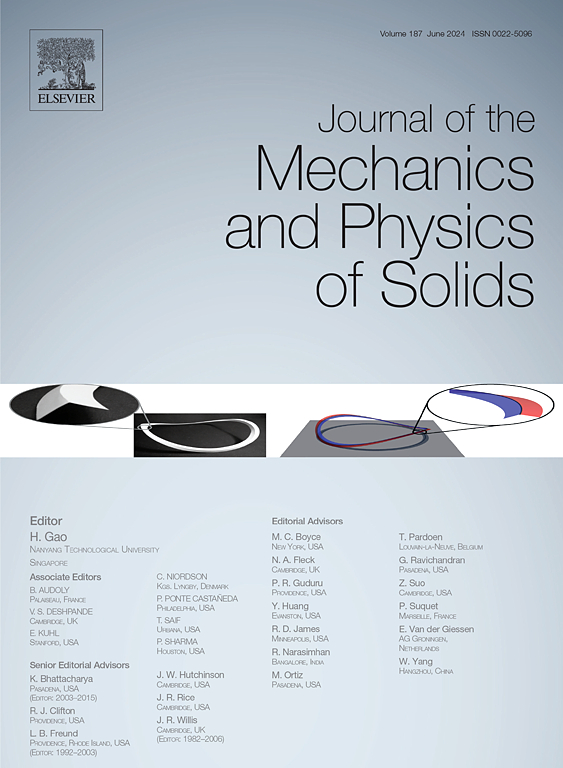Accretion and ablation in deformable solids using an Eulerian formulation: A finite deformation numerical method
IF 5
2区 工程技术
Q2 MATERIALS SCIENCE, MULTIDISCIPLINARY
引用次数: 0
Abstract
Surface growth, i.e., the addition or removal of mass from the boundary of a solid body, occurs in a wide range of processes, including the growth of biological tissues, solidification and melting, and additive manufacturing. To understand nonlinear phenomena such as failure and morphological instabilities in these systems, accurate numerical models are required to study the interaction between mass addition and stress in complex geometrical and physical settings. Despite recent progress in the formulation of models of surface growth of deformable solids, current numerical approaches require several simplifying assumptions.
This work formulates a method that couples an Eulerian surface growth description to a phase-field approach. It further develops a finite element implementation to solve the model numerically using a fixed computational domain with a fixed discretization. This approach bypasses the challenges that arise in a Lagrangian approach, such as having to construct a four-dimensional reference configuration, remeshing, and/or changing the computational domain over the course of the numerical solution. It also enables the modeling of several settings – such as non-normal growth of biological tissues and stress-induced growth – which can be challenging for available methods.
The numerical approach is demonstrated on a model problem that shows non-normal growth, wherein growth occurs by the motion of the surface in a direction that is not parallel to the normal of the surface, that can occur in hard biological tissues such as nails, horns, etc. Next, a thermomechanical model is formulated and used to investigate the kinetics of freezing and melting in ice under complex stress states, particularly to capture regelation which is a key process in frost heave and basal slip in glaciers.
用欧拉公式计算可变形固体中的吸积和烧蚀:一种有限变形数值方法
表面生长,即从固体边界增加或减少质量,发生在广泛的过程中,包括生物组织的生长,凝固和熔化,以及增材制造。为了理解这些系统中的非线性现象,如破坏和形态不稳定,需要精确的数值模型来研究复杂几何和物理环境下质量添加和应力之间的相互作用。尽管最近在可变形固体表面生长模型的制定方面取得了进展,但目前的数值方法需要几个简化的假设。本文提出了一种将欧拉表面生长描述与相场方法相结合的方法。进一步发展了一种有限元实现方法,利用固定的计算域和固定的离散化对模型进行数值求解。这种方法绕过了拉格朗日方法中出现的挑战,例如必须构建四维参考配置,重新划分网格和/或在数值解决过程中改变计算域。它还可以对几种环境进行建模——例如生物组织的非正常生长和应力诱导生长——这对于现有的方法来说是具有挑战性的。数值方法在一个显示非正常生长的模型问题上得到了证明,其中生长是通过表面在与表面法线不平行的方向上的运动而发生的,这种情况可能发生在坚硬的生物组织中,如指甲、角等。其次,建立了一个热力学模型,并用于研究复杂应力状态下冰的冻结和融化动力学,特别是捕捉冰川冻胀和基底滑动的关键过程。
本文章由计算机程序翻译,如有差异,请以英文原文为准。
求助全文
约1分钟内获得全文
求助全文
来源期刊
CiteScore
9.80
自引率
9.40%
发文量
276
审稿时长
52 days
期刊介绍:
The aim of Journal of The Mechanics and Physics of Solids is to publish research of the highest quality and of lasting significance on the mechanics of solids. The scope is broad, from fundamental concepts in mechanics to the analysis of novel phenomena and applications. Solids are interpreted broadly to include both hard and soft materials as well as natural and synthetic structures. The approach can be theoretical, experimental or computational.This research activity sits within engineering science and the allied areas of applied mathematics, materials science, bio-mechanics, applied physics, and geophysics.
The Journal was founded in 1952 by Rodney Hill, who was its Editor-in-Chief until 1968. The topics of interest to the Journal evolve with developments in the subject but its basic ethos remains the same: to publish research of the highest quality relating to the mechanics of solids. Thus, emphasis is placed on the development of fundamental concepts of mechanics and novel applications of these concepts based on theoretical, experimental or computational approaches, drawing upon the various branches of engineering science and the allied areas within applied mathematics, materials science, structural engineering, applied physics, and geophysics.
The main purpose of the Journal is to foster scientific understanding of the processes of deformation and mechanical failure of all solid materials, both technological and natural, and the connections between these processes and their underlying physical mechanisms. In this sense, the content of the Journal should reflect the current state of the discipline in analysis, experimental observation, and numerical simulation. In the interest of achieving this goal, authors are encouraged to consider the significance of their contributions for the field of mechanics and the implications of their results, in addition to describing the details of their work.

 求助内容:
求助内容: 应助结果提醒方式:
应助结果提醒方式:


